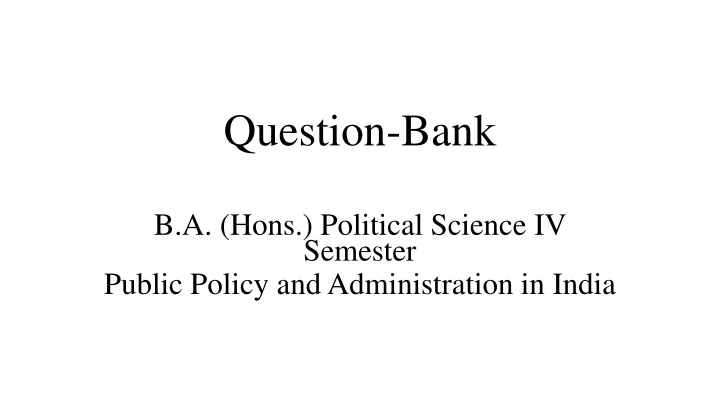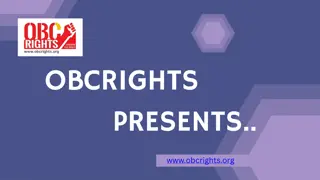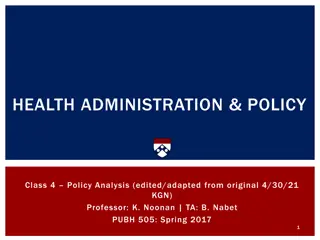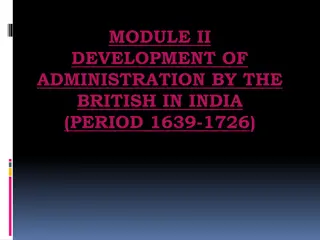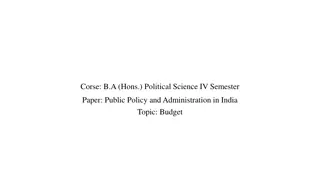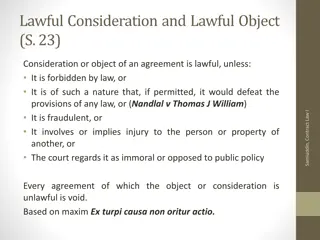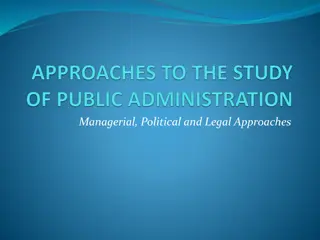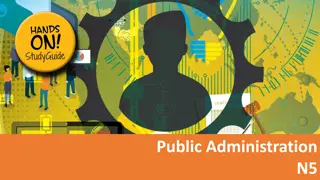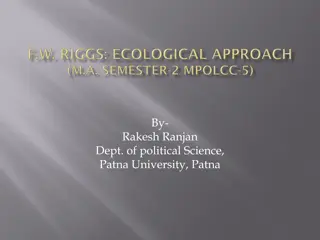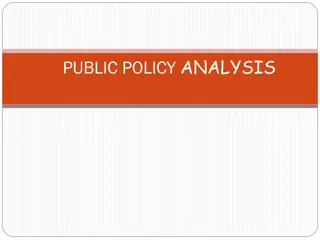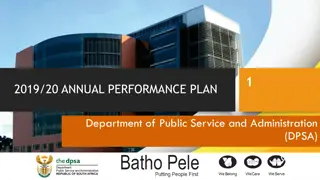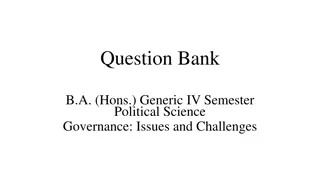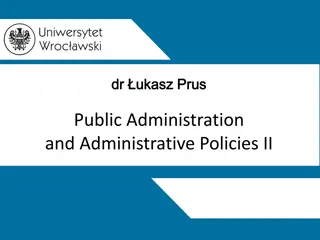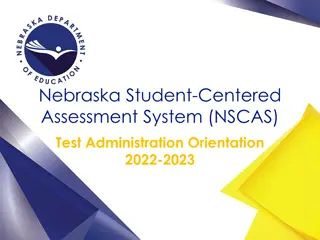Comprehensive Study on Public Policy and Administration in India
This question bank covers various aspects of public policy and administration in India, including definitions, analysis, role of institutions, civic engagement, global influences, impact of e-governance, and social welfare programs. It explores the significance and challenges of policy-making, implementation, and governance structures within the Indian context.
Download Presentation

Please find below an Image/Link to download the presentation.
The content on the website is provided AS IS for your information and personal use only. It may not be sold, licensed, or shared on other websites without obtaining consent from the author.If you encounter any issues during the download, it is possible that the publisher has removed the file from their server.
You are allowed to download the files provided on this website for personal or commercial use, subject to the condition that they are used lawfully. All files are the property of their respective owners.
The content on the website is provided AS IS for your information and personal use only. It may not be sold, licensed, or shared on other websites without obtaining consent from the author.
E N D
Presentation Transcript
Question-Bank B.A. (Hons.) Political Science IV Semester Public Policy and Administration in India
1. Discuss the meaning, nature and significance of public policy. 2. What is policy analysis? Describe the process of policy analysis. 3. What is Public Policy? Discuss its significance and scope. 4. What is public policy? Evaluate the role of experts in policy making. 5. Examine the various models of public policy making. 6. Describe policy analysis in the context of liberal and welfare theories of state. 7. Critically examine the role of institutions in the formulation of public policy in India.
8. Public Policy is the lifeline of Public Administration. Discuss. 9. NGOs are a means to ensure people s participation in Public Administration. Comment. 10. Write an essay on Government-civil society interface in policy making. 11. Discuss the major limitations in policy implementation. 12. Throw light on the disinvestment policy in India since 1991. 13. Examine the role of civil society organizations in policy-making and suggest measures to improve their relationship with the Government. 14. Examine the major constraints which affect the policy-making process in India.
15. Discuss the Inter-governmental structures and processes and analyze their role in policy-making. 16. Discuss the role and responsibilities of administrative organizations in policy implementation. 17. What is good governance? Discuss its main principles. 18. Critically examine the role of Social Welfare Administration in protecting the interests of weaker sections. 19. What do you understand by Public Grievances? Discuss the various devices for the redressal of citizen s grievances. 20. What is E-Governance? To what extent, has it improved governance in India? Discuss.
21. Do you believe that the corporate houses influence the political decision making process. Justify citing illustrations. 22. Discuss the role of Global Civil Society in the context of a globalized world. 23. What are the major threats to state sovereignty? Do you think globalization has hastened the demise of the nation state? 24. Describe the impact of globalization on state sovereignty. 25. Explain the impact of e-governance on the administrative system in India by citing few examples. 26. Right to information is an effective mechanism for redressal of public grievances. Discuss.
27. Define decentralization. Discuss the importance of 73rd Constitutional Amendment act for ensuring local self-governance in India. 28. Budget is a powerful instrument of socio-economic change. Comment 29. Examine the objectives and impact of MGNREGA as a social security programme. 30. Critically examine the Right to Food Security as an instrument of social welfare. 31. What is public policy? Discuss its various approaches. 32. Citizen s participation in local governance is essential for the success of democratic decentralization. Discuss.
33. Examine budget as social-economic tool of development in India. 34. How does E-Governance facilitate the interface between citizen and administration? Elaborate your answer with examples. 35. What is Public Service Delivery and how far has it been successful? Explain. 36. Discuss the salient features and relevance of 73rd Constitutional Amendment Act. 37. Write a short essay on Right to Education. 38. Briefly discuss the various models of Public policy. In your view which model of public policy is more relevant and why?
39. Discuss the process of public policy making in India. 40. Critically examine the salient features of Mahatma Gandhi Rural Employment Guarantee Act, 2005 (MGNREGA). 41. What do you understand by decentralization? Discuss the various forms of decentralization. 42. 74th Constitutional Amendment Act has revitalized the local government in urban areas. Elaborate. 43. Write an essay on budgetary processes in India. 44. Right to Information is an effective instrument for ensuring transparency and accountability. Discuss.
45.What is meant by state? 46. Distinguish state from government. 47. Explain the meaning of governance. 48. List the key characteristics of governance. 49. Name some important institutions created by the Constitution of India 50, What are citizens' charters? 51. Suggest few measures for tackling the challenges facing governance 52. What do you understand by economic liberalization? Has economic liberalization helped in poverty alleviation in India?
53. Discuss globalizations consequences on state sovereignty. 54. In the era of globalization, environmental issues are not state specific, rather they are global in dimension. Do you agree with the above statement? Give reasons. 55. Short notes on the following: 1. Models of Public Policy 2. Interest groups and policy 3. Role of Prime Minister s Office in policy-making 4. Policy cycle 5. Policies for Inclusive development Lok Pal
6. Right to Education 7. E-Governance 8. Public Delivery System 9. National Health Mission 10. Right to Food Security 11. Types of budget 12. Citizen s Charter 13. Right to Information 14. E-Governance 15. Civil Society 16. Role of NGOs in India. 17. System model of Public policy 18. Green Budget
